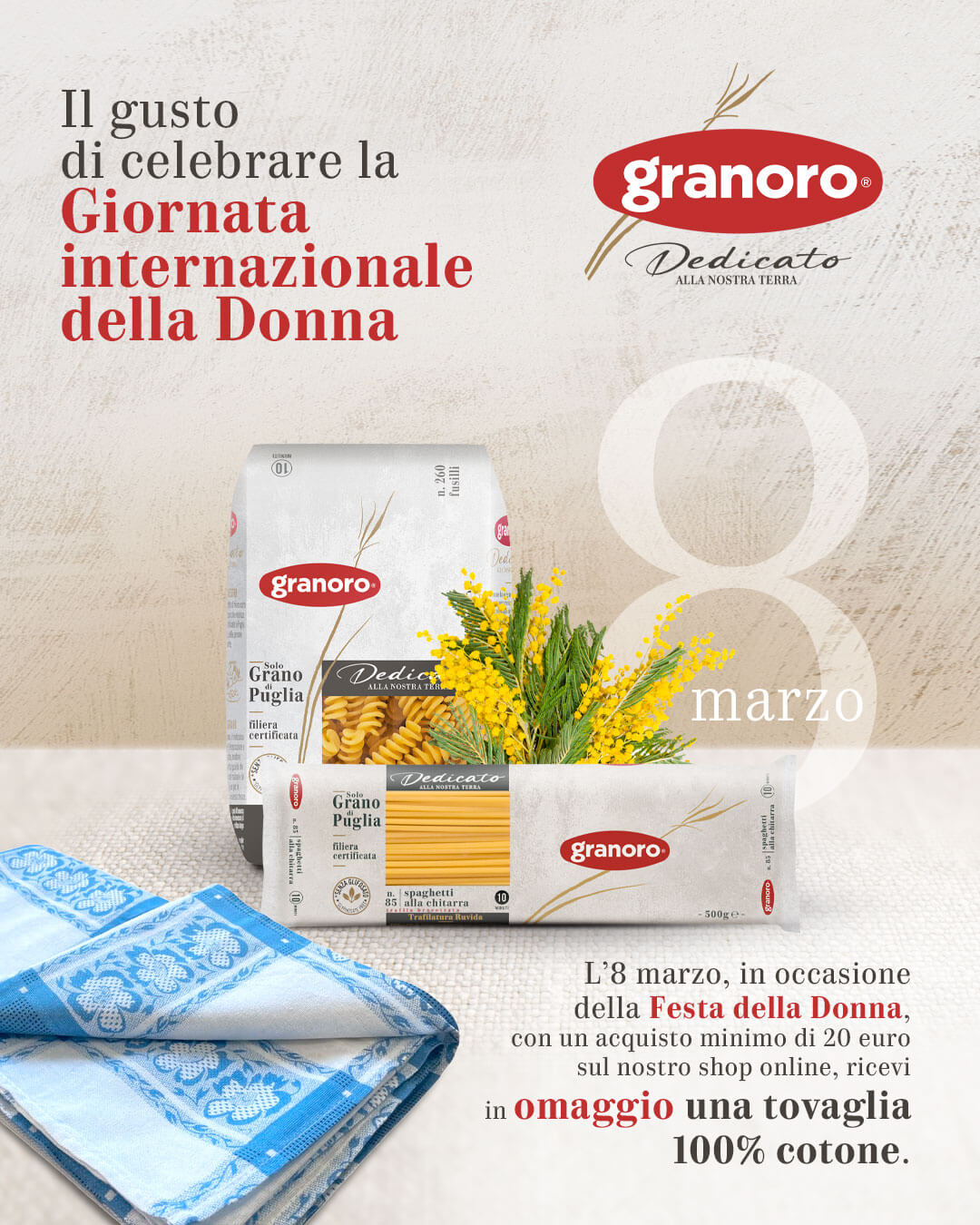A land of masters
The pasta production of Granoro
Layout, process and product innovation guarantee quality and respect for the needs of those who want to bring the best to the table, every day.
A dedication to quality
Granoro produces quality Italian pasta in over 150 different sizes and offers a wide range of products related to the traditional Italian “first course”: sauces, condiments, boiled and dried legumes, and Extra Virgin Olive Oil. Producing traditional, high-quality Italian pasta, in all the lines, Classic, Organic, Supply Chain, with only 100% wheat grown in Puglia, is the underlying principle and vocation that has characterised the lifelong work of the founder Attilio Mastromauro and his daughters, Marina and Daniela, who have been running the Pasta Factory with him since the mid-1980s. A passion and commitment that continue still today.
Granoro production in numbers
Twenty thousand square metres of the factory surface area are covered
The capacity of the self-supporting automatic warehouse alone
Production lines
Quintals of pasta produced per day
The selection of raw materials

For high-quality pasta, the selection of raw materials is important. The quality of Granoro pasta is achieved by using only high-quality durum wheat semolina obtained from the heart of the wheat kernel, uniformly yellow in colour and free of bran particles, with the correct protein content to ensure the presence of quality, firm and elastic gluten.
The raw material, the semolina, is purchased from the mills on the basis of strict quality standards and is carefully checked in the acceptance phase by our in-house laboratory.
Gluten
Granoro pasta has an excellent quantity and quality of proteins, in particular gliadin and glutenin which, due to the mechanical action of kneading and in the presence of water, combine and form a viscoelastic protein complex called gluten.
Gluten is a protein network that has the function of retaining starch granules during the cooking phase, preventing them from dispersing into the water. For this reason, our pasta does not appear “floury” on the outside after cooking, but is firm and elastic, and after cooking, it does not clump together on the plate.
The quantity and quality of these proteins directly influence the final quality of the product. Gliadins give elasticity and extensibility to gluten, while glutenins give firmness and consistency, characteristics that we recognise in excellent pasta.
Among the advantages that come from the ability of gluten to retain hydrated starch granules there is also the increase in the weight yield of the dry product, after cooking.

The dough
Granoro pasta is produced via a manufacturing process that is very attentive to the phase of mixing the semolina with water, so as not to damage the gluten and to keep it intact. In this phase, the hydration and mechanical action that takes place in the kneading tanks are decisive for the formation of gluten.
Starch is a complex sugar that is very important for our organism, in particular for the functioning of our entire body and brain, which is why it is important for it not to be lost in water during cooking.
Details of the cooking phase under a microscope
While cooking, by observing the structure of the pasta under a high-power microscope, you can see how the starch, as it absorbs water, swells and is retained by the gluten protein network. If this process remains intact at the end of the entire production phase, the pasta that is obtained will have visibly clear cooking water and no residues. All this is to the advantage of digestibility and yield.

If the protein network is compact and firm, the starch granules will be retained inside it without being lost in the water.

If the protein network breaks down due to a low quality and quantity of the proteins that make up the gluten, the starch will be lost in the water.
Extrusion and the draw-plates

The dies are the accessories that shape the dough made of water and semolina and are used to create the different pasta shapes. They also affect the characteristics of the pasta, the thickness of each shape, and the development and consistency of the gluten. It is the gluten that determines, after cooking, the elasticity and firmness needed to achieve what we commonly call “al dente” pasta.
Uniform cooking
In the Granoro pasta production process, the choice of extrusion is crucial to giving the different shapes the right porosity and an adequate thickness.[Ritorno a capo del testo]All Granoro shapes are designed to obtain uniform cooking and have a balanced cooking time with respect to the shape, use and choice of recipe.
Good-quality pasta should not be raw inside when cooked properly.
The thicker a size is, the longer it will take to cook. Consequently, it is preferable not to overdo the thicknesses so as not to have a difference in cooking between the inside and outside, with the result that the outside would tend to lose its desired consistency. The flaking of the external surface causes stickiness on the surface (floury patina) and leads to a decrease in the digestibility of the pasta.

Drying
Drying is a crucial process in obtaining good-quality pasta.
After extrusion, the pasta has a high water content which, following the drying process, must reach 12.5%, the maximum percentage of humidity prescribed by current legislation (Presidential Decree 187 of 9 February 2001).
To produce quality pasta, drying, in the Granoro Pasta Factory, is carried out in such a way as to obtain uniform and homogeneous evaporation of the water.
Granoro never uses very high temperatures
Drying at high temperatures gives pasta only an apparent quality. In fact, high and very high temperatures give pasta better cooking resistance even if semolina that is not of excellent quality is used. This process actually triggers a reaction that changes the colour of the pasta and above all, compromises the availability of some nutritional elements such as lysine, which is not only an essential amino acid but also one of the amino acids least present in cereals. It follows that with high temperatures the organic value of proteins is also reduced.
The importance of essential amino acids comes from the fact that humans are unable to synthesise them in sufficient quantities, and therefore they must be acquired through food.
For a very specific choice, Granoro chooses to carry out the drying process in a balanced way withoutusinghigh temperatures,sothat all the nutritional and organoleptic characteristics of durum wheat semolina, such as flavour and colour, are not altered, but are enhanced and preserved in each grain of pasta.
A pasta with excellent yield
After drying, Granoro pasta is ready to be packaged and distributed throughout the world.
The quality of the raw materials and the special manufacturing process studied by the founder Attilio Mastromauro, applied with the same care by his daughters Marina and Daniela and by the Technical Staff of the Pasta Factory, give Granoro pasta the right porosity, which guarantees a high capacity for absorbing water while cooking.
Excellence is best judged in cooking
Granoro pasta has excellent yield after cooking.[Ritorno a capo del testo]From 100g of raw pasta, depending on the shape, you get between 200g and 250g of cooked product. This is thanks to the porosity and water absorption capacity of the pasta during cooking, while maintaining its consistency and firmness.












